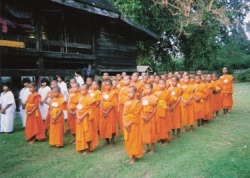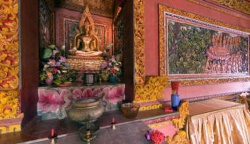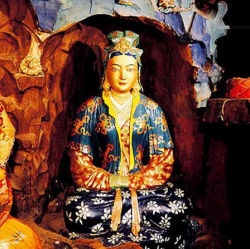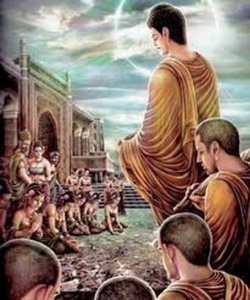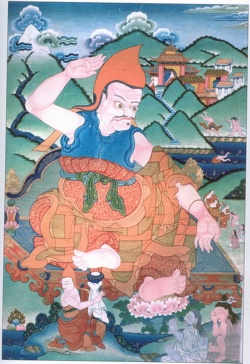The Tanjur Bodhicaryāvatāra auxiliaries: a few collected bibliographical pointers
There are several works of literature transmitted in the Tanjur related to Śāntideva’s masterpiece Bodhicaryāvatāra (Bca), and unfortunately nearly all of them have been lost in their original Sanskrit versions (on them cf. Dietz: Śāntideva’s Bca – das Weiterwirken des Werkes dargestellt anhand der Überlieferungsgeschichte des Textes und seiner Kommentare [Lecture script) {Buddhismus in Geschichte und Gegenwart 3: Śāntideva’s “Eintritt i.d. Leben zur Erleuchtung.” Hamburg 1999, p. 27-41}, p. 35 sq. [IV. Die Kommentare zum Bca]; Ejima: Nyūbodaigyōron no chūshaku bunken ni tsuite {Indogaku Bukkyōgaku Kenkyū /Journal of Indian and Buddhist Studies 14,2 (1966), p. 644-48}; Williams: On Prakṛtinirvāṇa / Prakṛtinivṛta i.t. Bca {Altruism and reality. Studies i.t. philosophy of the Bca. Richmond 1998, p. 1-28 = *Asiatische Studien / Etudes Asiatiques 46,1 (1992), p. 516-50}, p. 3 sq. [1. Indian commentaries]). There are (in order of appearance):
1. The Bodhicaryāvatāra-Pañjikā (byaṅ chub kyi spyod pa la ‘jug pa’i dka’ ‘grel, Q 5273, 221 (la / mdo ‘grel 26), 45a7-325a5; facsimile ed. vol. 100) [1] by Prajñākaramati (Śes rab ‘byuṅ gnas blo gros) is a extensive commentary on the chapters 1-9 of the Bca. Besides its Tibetan carrier the text also survived in the original Sanskrit through a few very precious antique palm leaf manuscripts kept in Kolkata (cf. this former blog contrib), which has been edited three times: the 9th chapter in 1898 by La Vallée Poussin (1869-1938); the full text by the same in 1901-14 for the Bibliotheca Indica series and later again by Vaidya (1891-1978)[2] in 1960 for the Buddhist Sanskrit Text series; due to folio loss unfortunately there are two large lacunae, 3,22-4,45 and 8,109-186 [end of the 8th chapter) haven’t made it.[3] Prajñākaramati lived at the end of the 1st millennium and was a teacher and a so-called “gatekeeper” (an examiner?) of the famous Vikramaśīla university considered to be located in the Bhagalpur district of modern Bihar (cf. Bose: Indian teachers of Buddhist universities.
Adyar 1923, p. 50 sq. [4. Prajñākaramati); Dutt: Buddhist monks and monasteries of India. London 1962, p. 358 sq. [b. Vikramaśīlā]. Towards the patronage of the Pālas in general cf. the introduction chapter of: Huntington: Leaves from the bodhi tree. The art of Pāla India (8th-12th centuries). Seattle (etc.) 1990; and most recently: Sanderson: The Śaiva age {Einoo (Ed.): Genesis and development of Tantrism. Tokyo 2009, p. 41-349 [!]}, p. 87 sq. [The Pāla emperors and the great monasteries of eastern India]). In the colophons of the survived mss at the Asiatic Society of Bengal the author is called prajñākara (no. 3830) next to prajñākaramati (no. 3829, cf.
Hara Prasada Shāstri: Descriptive catalogue of the Sanskrit mss i.t. Government Collection 1: Buddhist mss. Calcutta 1917, p. 49 sq.), which Bose claims to be common (cf. op.cit., p. 52). Furthermore he is titulated paṇḍitabhikṣu, which was an academic title in the university.
2. The Bodhisattvacaryāvatāra[4]-Vivṛttipañjikā (byaṅ chub sems dpa’i spyod pa la ‘jug pa’i rnam par bśad pa’i <bka’i ] dka’> ‘grel, Q 5274, 221, 325a5-396a5) is an anonymous commentary on the shorter version of the Bca [5], and therefore employs 9 chapters while commenting also on the Pariṇāmanā, the 9th chapter of the Bca in its short version.[6] Saito writes that the author comments the text the from a Yogācāra-Mādhyamika point of view (cf. Saito: Śāntideva in the history of Mādhyamaka philosophy {Sankarnarayan/Yoritomi/Joshi (Eds.): Buddhism in India and abroad. Mumbai (etc.) 1996, p. 257-63}, p. 259). An edition of the 8th chapter of this text (commenting on the Prajñāpāramitāpariccheda) based on the Derge Tanjur (D. 3873, La 338a7-349a4) with variants could be found in Saito’s research report {A study of Akṣayamati (=Śāntideva)’s Bodhisattvacaryāvatāra as found in the Tibetan manuscripts from Tun-huang} from 1993, p. 57 sq.
3. The Bodhisattvacaryāvatāra-Saṃskāra (byaṅ chub sems dpa’i spyod pa la ‘jug pa’i legs par sbyar ba, Q 5275, 222 (śa / mdo ‘grel 27), 1-106a6) by Kalyāṇadeva (Dge ba’i lha), the “edition” of the Bca, is another commentary on the long version, but not as exhaustive and rich of citations as Prajñākaramati’s Pañjikā.
4. The Bodhisattvacaryāvatāra-Duravabodhanirṇaya-nāmagrantha (byaṅ chub sems dpa’i spyod pa la ‘jug pa’i rtogs par dka’ ba’i gnas gtan la dbab pa źes bya ba’i gźuṅ, Q 5276, 222, 106a7-112b4), “book with the name: discussion of difficult (portions)” by Kṛṣṇapāda (Kṛṣṇa ba) is, like the name suggests, a non-continuous commentary. The author was a Newar brahmin and disciple of Śāntibhadra, a Newar scholar of the 11th century (cf. Lo Blue: The role of Newar scholars in transmitting the Indian Buddhist heritage to Tibet (c. 750-c. 1200) {Karnay/Sagant: Les habitants du toit du monde (Festschrift A.W. MacDonald). Nanterre 1997, p. 629-58}, p. 639).
5. The Bodhisattvacaryāvatāra-Pañjikā (byaṅ chub sems dpa’i spyod pa la ‘jug pa’i dka’ ‘grel, Q 5277, 222, 112b4-186b7) by Vairocanarakṣita (Bai ro tsa na kṣi ta) is by its extend somewhat comparable to Kalyānadeva’s Saṃskāra. The author, also known as Vairocanavajra, was a contemporary of Atiśa (982-1054) and also a inhabitant of the Vikramaśīla university (cf. Schaeffer: The religious career of Vairocanavajra – a 12th century indian Buddhist master from Dakṣina Kośala {Journal of Indian Philosophy 28 (2000), p. 361-84}).
6. The Prajñāparicchedapañjikā (śes rab le’u’i dka’ ‘grel, Q 5278, 222, 186b7-210a5) is, like the name suggests, a commentary of the 9th chapter of the Bca.
7. The Bodhisattvacaryāvatāra-Vivṛtti (byaṅ chub sems dpa’i spyod pa la ‘jug pa’i rnam par bśad pa, Q 5279, 222, 210a5-223b2) is nearly identical with the last two chapters of the Vivṛttipañjikā (Q 5274, see above), and thus also refers to the shorter version of the Bca.
8. The Bodhisattvacaryāvatāra-Ṣaṭtriṃśat-piṇḍārtha (byaṅ chub sems dpa’i spyod pa la ‘jug pa’i don sum cu rtsa drug bsdus pa, Q 5280, 222, 223b2-227b5), and the
9. Bodhisattvacaryāvatāra-Piṇḍārtha (byaṅ chug sems dpa’i spyod pa la ‘jug pa’i don bsdus pa, Q 5281, 222, 227b5-229a7) are abridgements and consist of selected stanzas of the Bca (cf. Eimer: Suvarṇadvipa’s “commentaries” on the Bca {Bruhn/Wetzler: Studien zum Jainismus und Buddhismus (Festschrift Alsdorf). Wiesbaden 1981, p. 73-78}). The author is called in the colophon “Suvarṇadvipī Lama Dharmapāla” (Gser gliṇ gi bla ma chos skyoṅ), but that just refers to Atiśa’s teacher from Sumatra, Suvarṇadvīpa Dharmakīrti (Gser gliṅ pa chos kyi grags pa, cf. Eimer: Berichte über das Leben des Atiśa (Dīpaṃkaraśrījñāna). Wiesbaden 1977, p. 14, fn. 9).
10. The Bodhicaryāvatāra-tātparyapañjikā-Viśeṣadyotanī-nāma (ppbyaṅ chub kyi spyod pa la ‘jug pa’i dgoṅs pa’i ‘grel pa khyad par gsal byed ces bya ba]], Q 5282, 222, 229a8-343a4), was written and also translated by Vibhūticandra (rnal ‘byor zla ba). Karunaratne claims that the text is a sub-commentary on Prajñākaramati’s Pañjikā (cf. Bca-tātparyapañjikā-viśeṣadyotanī-nāma {Malalasekera (Ed.): Encyclopedia of Buddhism. Vol. 3: Bhārini-deva – Caura-vidhvaṃsana-n°. Sri Lanka 1971, p. 184 sq.}. In the beginning the text contains a short hagiographic biography of Śāntideva, which also survived in its Sanskrit original (cf. ms no. 9990 again i.t. Government Collection of the Asiatic Society of Bombay [what a precious collection they have got there, it taken scanned and put online would give a glorious major impulse for worldwide studies], no. 52 i.t. catalogue (op.cit., p. 51); examined by Jong as a review of Pezzali’s Śāntideva (Firenze 1968): La légende de Śāntideva {Indo-Iranian Journal 16,3 (1975), p. 161-82 = Buddhist Studies [Collected minor works]. Berkeley 1979, p. 119-40}). Master Vibhūticandra is not a minor figure, he was an important Kālacakra scholar and accompanied Śākyaśrībhadra (1127-1225) after Vikramaśīla was invaded in the 1190s first to the monastery of Jagtatalā in East Bengal, and then to Tibet in 1203 (cf. Bandurski: Übersicht über die Göttinger Sammlungen der von Rāhula Sāṅkṛtyayana in Tibet aufgefundenen buddhistischen Sanskrit-Texte {Bandurski u.a. (Eds.): Untersuchungen zur buddhistischen Literatur. Göttingen 1994, p. 9-125}, p. 22). The dates of his birth and death are unknown (cf. Das Gupta: Vibhūticandra of the Jagaddala Mahāvihāra {Indian Culture 5 (1938-39), p. 215-17}; Vogel: Lunar eclipses of the early 13th century predicted by the Buddhist master Vibhūticandra {Kollmar-Paulenz/Peter (Eds.): Tractata Tibetica et Mongolica (Festschrift Sagaster). Wiesbaden 2002, p. 305-11}; Stearns: The life and legacy of the Indian Mahāpaṇḍita Vibhūticandra {Journal of the International Association of Buddhist Studies 19,1 (1996), p. 127-71}).
These representations of Sanskrit works that have been lost suggest that there existed a vast literature on the Bca and maybe this again is only a cutout. Dietz points out that in the Duravabodhinirṇaya there are many references to unknown commentaries and subcommentaries (op.cit., p. 38). The Buddhist Sanskrit literature related to the Bca is a fascinating, challenging subject. A closer examination of the auxiliaries i.t. Tanjur remains a desideratum and could make a subject on its own.
Notes:
[1] Cf. the usual catalogues: Suzuki: The Tibetan Tripitaka. Catalogue & Index. Tokyo 1962, p. 639 sq.; *A comparative analytical catalogue of the Tanjur division of the Tibetan Tripitaka kept i.t. Otani Univ. Library. Kyoto 1965 ff. The other Tanjur editions could be located as always through the usual catalogues or a query at the general catalogue in Vienna.
[2] Obituary by B.V. Bapat i.t. Journal of the International Association of Buddhist Studies 1,1 (1978), p. 91 sq.
[3] Sometime some more Sanskrit mss which survived in Tibet are mentioned, cf. Martin: Tibskrit 2008, p. 1666: “KCDS [Microfilm catalogue of the Tibetan Cultural Research Center, Beijing], p. 150. Sanskrit palmleaf manuscript now belonging to the Potala”; Petech: Medieval history of Nepal (c. 750-1482). Roma 1984, p. 98: “23) Ms. of Prajñākaramati’s commentary on the Bca. Ṅor monastery in Tibet”, footnote: “… although the ms. seems to be listed in RS, XXI, 37 (no. 110) [refers to: Sāṅkrityāyana: Sanskrit palm-leaf mss. in Tibet {The Journal of the Bihar and Orissa Research Society 21 (1935), p. 21-43}, but no. 110 (p. 37) refers to a ms of the mūla). From a hand-copy made by Professor G. Tucci in 1939″ [not listed in: Sferra: Sanskrit mss and photos of Sanskrit mss in Guiseppe Tucci’s collection {Balcerowicz / Mejor (Eds.): On the understanding of other cultures (Festschrift Schayer). Warsaw 2000, p. 397-413}].
[4] In Tibetan the title Bodhisattvacaryāvatāra (sometimes refered to as “Bsa”) appears next to Bodhicaryavatāra. Lindtner claims that the longer version is original, Rachewiltz: The Mongolian Tanjur version of the Bodhicaryātāra. Wiesbaden 1966 [review] {Buddhist Studies Review 15,2 (1998), p. 238-40}, p. 239: “Moreover it is more important, the full title of the poem is Bodhisattvacaryāvatāra (rather than Bodhicaryāvatāra). This form is also supported by the Mongolian … Obviously, our poem is not an introduction to the life of bodhi, but to the career of a bodhisattva. The source of the abbreviated title probably the author himself.” But it’s a fact that the title Bca and even not a single time the longer version occurs everywhere in the Sanskrit transmission: India Office Library [incorporated into the British Library] ms no. 7713 colophon (cf. Keith: Catalogue of the Prākrit mss i.t. library of the India Office 2: Brahmanical and Jaina mss. Oxford 1935, p. 1394), Minaev’s own ms “M” (cf. Spasenie po učeniju pozdnějšich buddhistov [[[Wikipedia:Salvation|Salvation]] according to the teachings of the late Buddhist) {Zapiski Vostočnago Otdělenija Imperatorskago Russkago Archeologičeskago Obščestva [Memoirs of the Oriental Section of the Imperial Russian Archaeological Society) 4 (1889), p. 153-228}, p. 154); i.t. colophons of the mss no. 78 & 79 of Filliozat’s catalogue of the Sanskrit stocks of the French national library (Catalogue du fonds sanscrit 1: nos. 1 à 165. Paris 1941, p. 63); in no. 8067 i.t. Government Collection of the Asiatic Society of Bengal (op.cit., no. 19, p. 21) etc. etc. That the longer version of title is to be found also in Mongolian for me is no argument, that the Mongolian version of the text (and so its title) derived from the Tibetan has been found out already by Weller (cf. Über den Quellenbezug eines mongolischen Tanjurtextes. Berlin 1950 [Abhandlungen d. Sächsischen Akademie d. Wissenschaften zu Leipzig, phil.-hist. Klasse; 45,2]. On the Monglian translations in general see: Sagaster: Übersetzungen vom Tibetischen ins Mongolische und umgekehrt).
[5] The shorter version of the Bca, also lost in its original Sanskrit version, is transmitted in Tibetan outer-canonically and has been found in Dunhuang on the Silk Road. It employs 9 chapters in 701 verses while the longer version consists of 10 chapters and 913 verses; chapter 2 and 3 of the longer version are combined here, the verses there which are related to the ritual of taking the bodhisattva vow (saptavidhānottarapūjā, cf. Gómez: Bodhicitta (thought of awakening) {Buswell: Encyclopedia of Buddhism. Vol. 1: A-L. New York 2004, p. 54-56}) are still absent here and there are other interesting differences, mainly in the 5th chapter. The short version has been examined and edited by Saito in research projects of Mie University (cf. A study of Akṣayamati’s (=Śāntideva’s) Bodhisattvavaryāvatāra as found in the Tibetan mss from Tun-huang. Project no. 02801005 [Research project report, 1993]; A study of the Dūn-huáng recension of the Bodhisattvacaryāvatāra. Project no. 09610021 [Research project report, 2000]), and there is a vast (mostly Japanese) literature on that subject and its issues like the Akṣayamati hypothesis (that the authors original name is Akṣayamati and not Śāntideva), the Tabo ms of the Bca (cf. Saito: Remarks on the Tabo ms of the Bodhisattvacaryavatāra {Scherrer/Schaub: Tabo Studies II. Manuscripts, texts, inscriptions, and the arts. Roma 1999, p. 175-89}) etc.
[6] That the 10th chapter of the Bca (in its vulgate long version) is not original has been brought forward the first time by La Vallée Poussin in the French translation of the text (Bodhicaryāvatāra. Introduction a la pratique des futurs bouddhas. Paris 1907, p. 143 sq. [Note finale]: “Il entrait dans mon intention de publier la traduction du dixième chapitre du Bca …”). But this has been doubted among others by Ruegg (The literature of the Madhyamaka school of philosophy in India. Wiesbaden 1981, p. 83: “The authenticity of this final chapter has been questioned on the ground that not all commentators have commented on it, but this point does not appear to be decisive.” La Vallée Poussin didn’t recognised that some of the 9-chapter-commentaries are referring to another version of the mūla consisting only of 9 chapters anyway, and furthermore the fact that the Pañjikā omits the 10th chapter of the mūla does not mean necessarily that Prajñākaramati also considers it not to be original (another theory is that the Prajñāpāramitā chapter of the Pañjikā was written first and later the commentary on the chapters 1-8 as an addition, cf. this previous posting here). Dietz seeks to conclude the discussion pointing out that the Pariṇāmanā is to be found in just all known copies and versions of text, even the shorter Tibetan version and also the shorter Chinese version (Taishō no. 1662, Putixingjing (菩提行經), in 782 verses and 8 chapters), and I think that this is a decisive argument (cf. Dietz, op.cit., 30).
